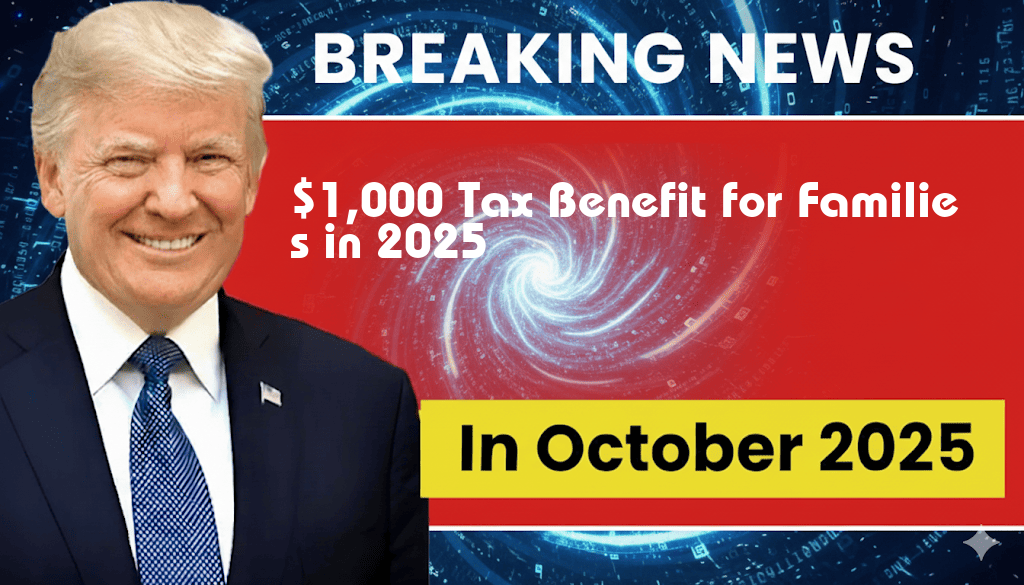In a significant move to support American families, the recently passed 2025 tax laws include a new $1,000 tax benefit aimed specifically at larger households. This initiative is designed to alleviate financial pressures on families, particularly those with three or more children. The tax benefit is part of a broader strategy by lawmakers to enhance family support systems and promote economic stability. Families can expect to see this benefit reflected in their tax filings starting in the 2026 tax year, providing much-needed relief amid rising living costs. As policymakers focus on fostering a more equitable tax structure, this new benefit is expected to positively impact millions of households across the country.
Details of the $1,000 Tax Benefit
The $1,000 tax benefit is structured to assist families with qualifying dependents. Here’s how it works:
- Eligible households must have at least three dependents.
- The benefit is applied directly to the family’s tax liability, effectively reducing the amount owed to the IRS.
- Families can claim the benefit during their annual tax return process.
Who Qualifies for the Tax Benefit?
To qualify for the $1,000 tax benefit, families must meet certain criteria:
- Must file taxes as a head of household, married filing jointly, or qualifying widow(er).
- Dependents must be under the age of 19 or under 24 if they are full-time students.
- Income thresholds will apply, ensuring that the benefit primarily aids middle and lower-income households.
Impact on Families and the Economy
This tax benefit is expected to have a wide-ranging impact on both families and the economy. By increasing disposable income for larger households, the initiative aims to:
- Reduce financial strain on parents struggling to provide for multiple children.
- Encourage spending in local economies as families have more funds for essentials and discretionary purchases.
- Promote family growth and stability, potentially influencing decisions on childbirth and child-rearing.
Expert Opinions on the Tax Benefit
Financial experts and economists have weighed in on the implications of this new tax policy. Dr. Emily Johnson, a tax policy analyst at the Institute for Taxation and Economic Policy, stated, “This tax benefit represents a significant step towards recognizing the financial challenges faced by larger families. It not only provides immediate relief but also promotes long-term economic stability.”
Similarly, Mark Stevens, a financial advisor, highlighted that “the benefit could lead to increased consumer confidence, as families feel more secure in their financial situations.” The ripple effects of this policy may extend beyond individual households, contributing to broader economic growth.
Potential Challenges and Considerations
Despite its advantages, some challenges and considerations accompany the implementation of the $1,000 tax benefit:
- Administrative complexity in determining eligibility and processing claims.
- Potential for increased scrutiny and audits as families navigate the new benefit.
- Concerns over the long-term sustainability of such tax benefits in light of federal budget constraints.
Future Legislative Developments
As the 2025 tax laws take effect, lawmakers are already discussing potential expansions or adjustments to the benefit. The conversation includes:
- Possible increases in the benefit amount based on inflation.
- Expanding eligibility to families with fewer than three children.
- Adjustments to income thresholds to better target assistance to those in need.
Conclusion
The introduction of the $1,000 tax benefit for larger households marks a pivotal moment in U.S. tax policy aimed at enhancing family welfare. As families prepare for the changes starting in the 2026 tax year, the impact of this benefit will be closely monitored by both supporters and critics. Continued discussions about further support for families are expected as lawmakers seek to address the evolving economic landscape.
For more detailed information on tax laws and family benefits, visit Forbes or Wikipedia.
Frequently Asked Questions
What is the $1,000 tax benefit for families under the 2025 laws?
The $1,000 tax benefit is a new financial support measure introduced under the 2025 tax laws aimed at helping larger households manage their expenses and improve their financial stability.
Who is eligible for the $1,000 tax benefit?
Eligibility for the $1,000 tax benefit generally includes families with dependents, particularly those with children or other qualifying individuals living in the household. Specific eligibility criteria may vary, so it is important to check the official guidelines.
How can families claim the $1,000 tax benefit?
Families can claim the $1,000 tax benefit when filing their annual tax returns. It is advisable to consult with a tax professional or use tax preparation software to ensure proper filing and to take full advantage of the benefit.
Will this tax benefit be available every year?
The $1,000 tax benefit is currently set to be available under the 2025 tax laws. Future availability may depend on changes in legislation or tax policy, so families should stay informed about any updates that may affect this benefit.
How does the $1,000 tax benefit impact family budgets?
The $1,000 tax benefit can significantly enhance family budgets by providing additional funds that can be used for essential expenses, savings, or investments. This support aims to alleviate some financial pressures faced by larger households.
